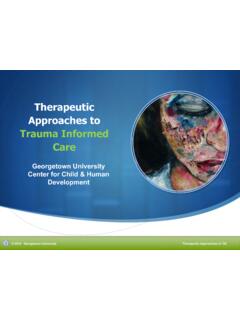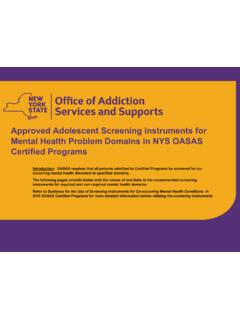Transcription of TIP What is Trauma Informed Care (TIC)
1 what is Trauma Informed care ? Purpose. This document provides general information about Trauma Informed care (TIC) especially for individuals new to this topic. Included are guiding considerations, principles and definitions offered by experts in the field. Background. TIC is based on growing knowledge about the negative impact of psychological Trauma . Trauma is common in society and among service recipients. The service system can re- traumatize individuals affecting their willingness to participate and engage. Harris and Fallot1 introduced the idea of TIC in their influential publication, Using Trauma Theory to Design Service Systems: New Directions for Mental Health Services. Since that time, significant effort has been made to define and clarify a Trauma Informed approach and incorporate this framework in policies, practices, and workforce development.
2 Although service providers and agency leaders are anxious to implement Trauma Informed practices, much of the conversation about TIC remains abstract. As more becomes known about the application of TIC, the service sector will benefit from practical and concrete examples for implementation. Definition. Despite years of work in this field, there is not a common definition of TIC. The field should strive to create a definition that includes the following: An awareness of the prevalence of Trauma ; An understanding of the impact of Trauma on physical, emotional, and mental health as well as on behaviors and engagement to services; and An understanding that current service systems can retraumatize individuals. One example by Hopper, Bassuk & Olivet2 combines definitions of TIC from several experts in the field and provides what they call a consensus definition (see box below).
3 Trauma - Informed care is a strengths based framework that is grounded in an understanding of and responsiveness to the impact of Trauma , that emphasizes physical, psychological, and emotional safety for both providers and survivors, and that creates opportunities for survivors to rebuild a sense of control and empowerment. (Hopper, Bassuk, & Olivet, 2010) Trauma Informed care vs. Trauma Specific Services? Trauma Specific Services (TSS) are programs, interventions, and therapeutic services aimed at treating the symptoms or conditions resulting from a traumatizing event(s). Trauma Informed care (TIC) is an approach, based on knowledge of the impact of Trauma , aimed at ensuring environments and services are welcoming and engaging for service recipients and staff. The Substance Abuse and Mental Health Administration3 offers the four Rs as a helpful way to think about TIC (see box at left) TIC will look different in every setting, based on unique individuals and organizations.
4 Whether viewed as a culture shift, a framework, or a lens through which services can be viewed - a commitment must be made to: Culturally responsive principles Service recipient involvement Workforce development A Trauma Informed approach would be experienced by all involved as a profound cultural shift in which consumers and their conditions and behaviors are viewed differently, staff respond differently, and the day- to- day delivery of services is conducted differently (Jennings, 2004, p. 21)4 Principles of TIC. Many principles, values, and beliefs have been The used to guide TIC practice. Those shown in the box Principles of TIC are well accepted in the field. 1. Harris, M., & Fallot, R. (Eds).
5 (2001). Using Trauma Theory to Design Service Systems: New Directions for Mental Health Services. 2. Hopper, E. K., Bassuk, E. L., & Olivet, J. (2010). Shelter from the Storm: Trauma - Informed care in Homelessness Services Settings. 3. Substance Abuse and Mental Health Services Administration. (2012). SAMHSA s Working Definition of Trauma and Principles and Guidance for a Trauma - Informed Approach 4. Jennings, A. (2004). Models for Developing Trauma - Informed Behavioral Health Systems and Trauma -Specific Services. Trauma Informed Oregon is funded through Oregon Health Authority, and is a partnership between Portland State University, Oregon Health Sciences University and Oregon Pediatric Society. In writing these TIPs, Trauma Informed Oregon will strive for easy to read text, avoiding technical language and spelling out acronyms as needed. For TIPs that include information from other sources this may not always be possible. Principles of Trauma Informed care Trauma Awareness: Those who are Trauma Informed will understand the prevalence and impact of Trauma among their service recipients and within the workforce.
6 Policy and practice reflect this awareness and may be supported with activities such as screening and assessments. Safety: Policy and practice reflect a commitment to provide physical and emotional safety for service recipients and staff. Choice & Empowerment: to facilitate healing and avoid re-traumatization, choice and empowerment are part of Trauma Informed service delivery, for both service recipients and staff. Strengths Based: With a focus on strength and resilience, service recipients and staff build skills that will help them move in a positive direction. (Hopper, Bassuk, & Olivet, 2010) A program, organization, or system that is Trauma Informed : Realizes the widespread impact of Trauma and understand potential paths for recover; Recognizes the signs and symptoms of Trauma in clients, families, staff, and others involved with the system; Responds by fully integrating knowledge about Trauma into policies, procedures, and practices; and seeks to actively resist re-traumatization Substance Abuse Mental Health Administration (SAMHSA, 2012)







